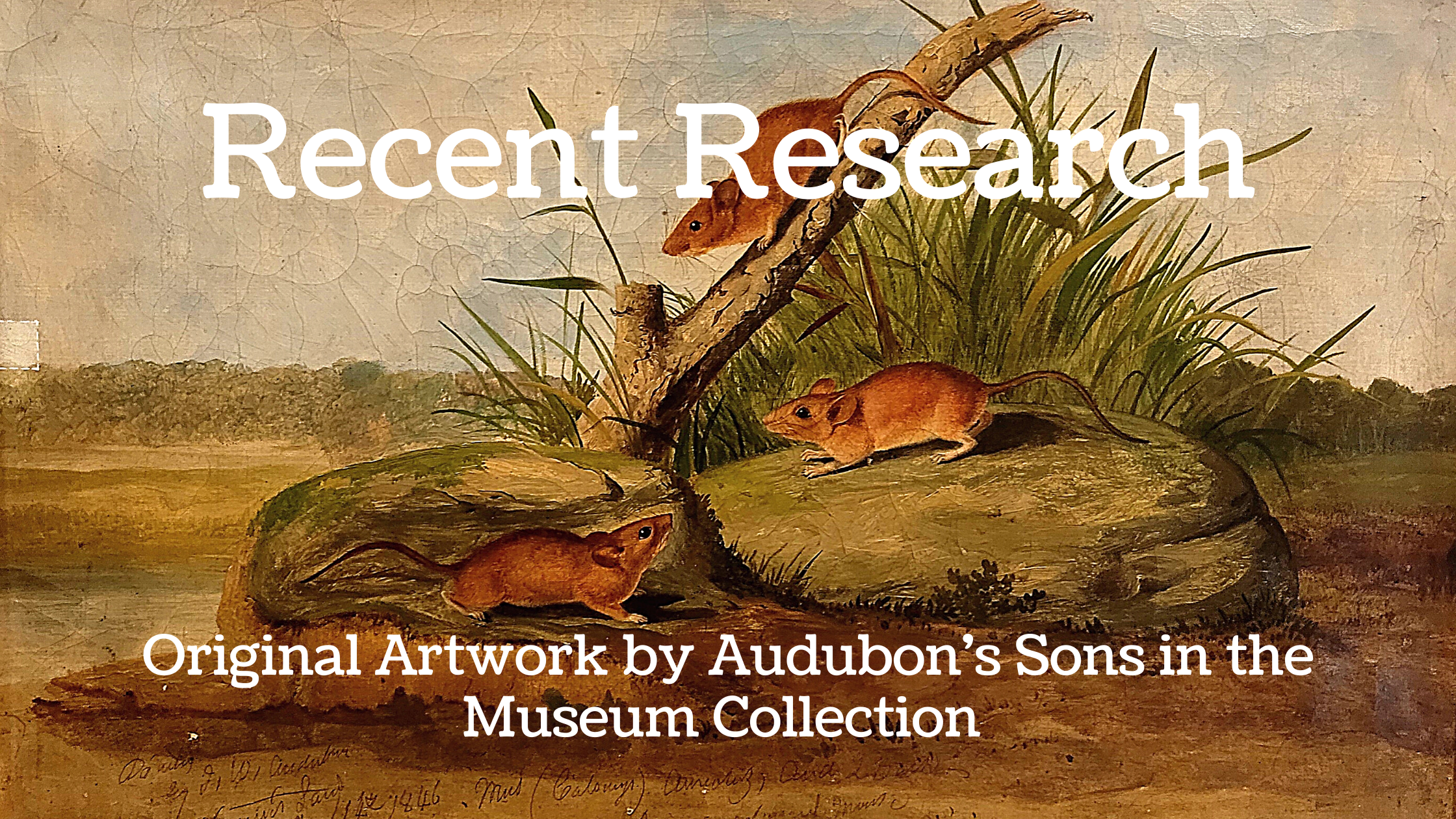In our Recent Research series, curator Heidi Taylor-Caudill shares answers to questions sent to the Audubon Museum about John James Audubon and his family, the museum’s collection, and the history of John James Audubon State Park.
John James Audubon (1785-1851) is famous for his illustrations of birds and other wildlife, but did you know that his two sons were also talented artists? In January 2021, a person called me to ask about John James Audubon’s son, John Woodhouse Audubon, and his involvement in the California Gold Rush. We had a nice conversation about the topic, and they were surprised to learn that our museum holds a number of original paintings, drawings, and other artistic works by Audubon’s sons – Victor Gifford Audubon (1809-1860) and John Woodhouse Audubon (1812-1862).
This post offers a list of their artwork currently in our collection. You will see original landscapes, seascapes, and architectural paintings by Victor Gifford Audubon. He was the eldest son and served as his father’s business manager for The Birds of America and other projects. Other works – portraits and wildlife paintings – were done by John Woodhouse Audubon. He was Audubon’s youngest son and worked with his father on illustrations for The Birds of America and the Viviparous Quadrupeds of North America.
All of these pieces – with the exception of one collected by Susan Starling Towles – are part of the L.S. Tyler Collection and were handed down through the descendants of John James Audubon. Alice Tyler, the widow of Audubon’s great-grandson, Leonard Sanford Tyler, placed this collection of original artwork and artifacts on loan to Audubon State Park in 1938. The Tyler Collection was later purchased in 1994 through numerous donations made to the Friends of Audubon, as well as contributions from the Preston Foundation and the Kentucky Department of Parks.
Currently there are seventeen original paintings in our holdings that we attribute to John Woodhouse Audubon and Victor Gifford Audubon. As of the publication of this post, two works are on display in the galleries and fifteen works are resting in storage. The two paintings on display were both done by John Woodhouse for the Viviparous Quadrupeds of North America.
Interested in learning more about these works of art? Check out the list below for images and details. You can also feel free to contact me with questions at 502-782-9716 or [email protected].
Works by John Woodhouse Audubon
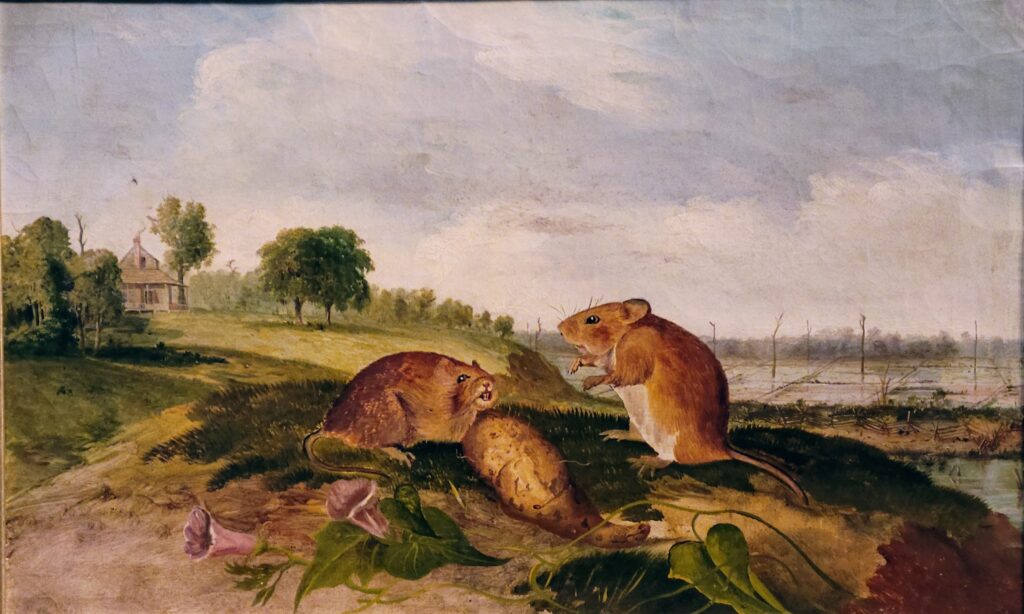
Oil on canvas
John Woodhouse Audubon (1812-1862)
Susan Starling Towles Collection, JJA.1938.1722
Current Location: Storage
This oil painting by John Woodhouse Audubon depicts two ground rats gathered around a sweet potato. One rat is standing upright facing to the left, while the other rat is crouched low facing the viewer. In the background is a farmhouse situated on a hill, a small body of water, and farmland.
Collected by Susan Starling Towles (1861-1954) and donated to the Audubon Museum in 1938.
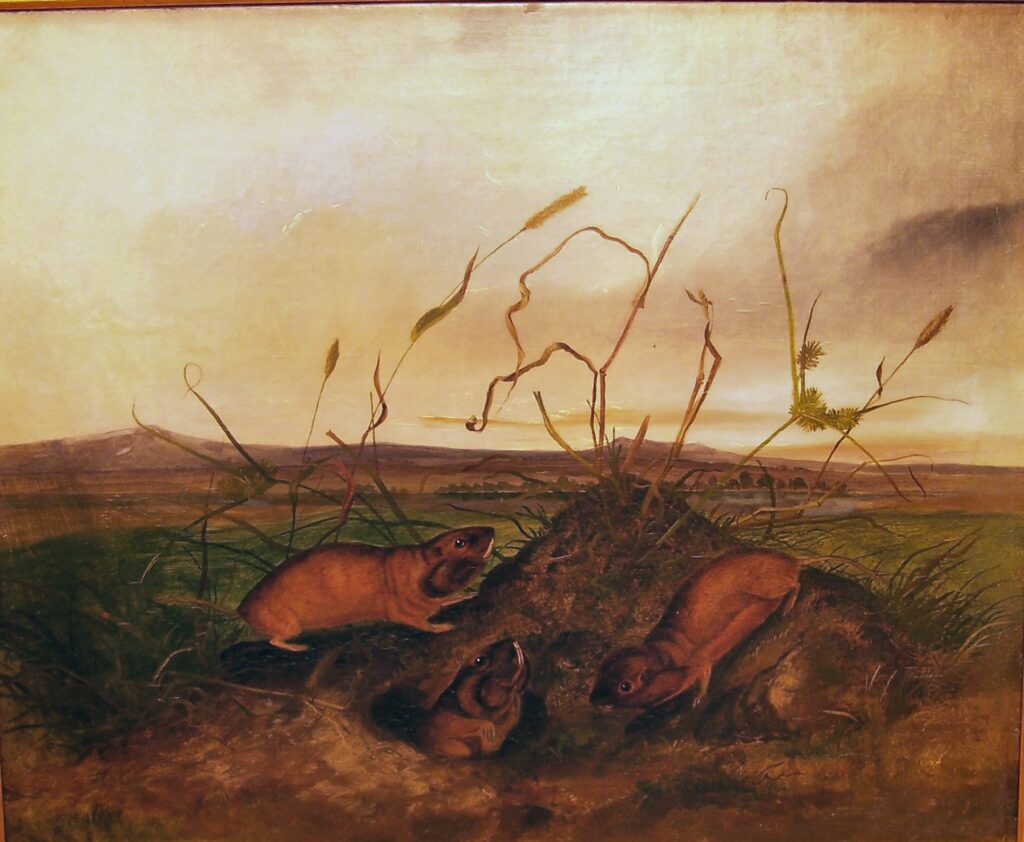
Oil on canvas
John Woodhouse Audubon (1812-1862)
L.S. Tyler Collection, JJA.1938.1327
Current Location: Storage
This oil painting was done by John Woodhouse Audubon for the Viviparous Quadrupeds of North America. It depicts two rats gathered beside their nest and one rat sticking its head out of the opening to the nest. Scraggily grass surrounds the rats. In the background is a river and gently rolling hills. The sky is grey-blue with purple, light pink, and dark grey clouds.
The Tyler Collection was purchased in 1994 through numerous donations made to the Friends of Audubon State Park, as well as contributions from the Preston Foundation and the Kentucky Department of Parks.
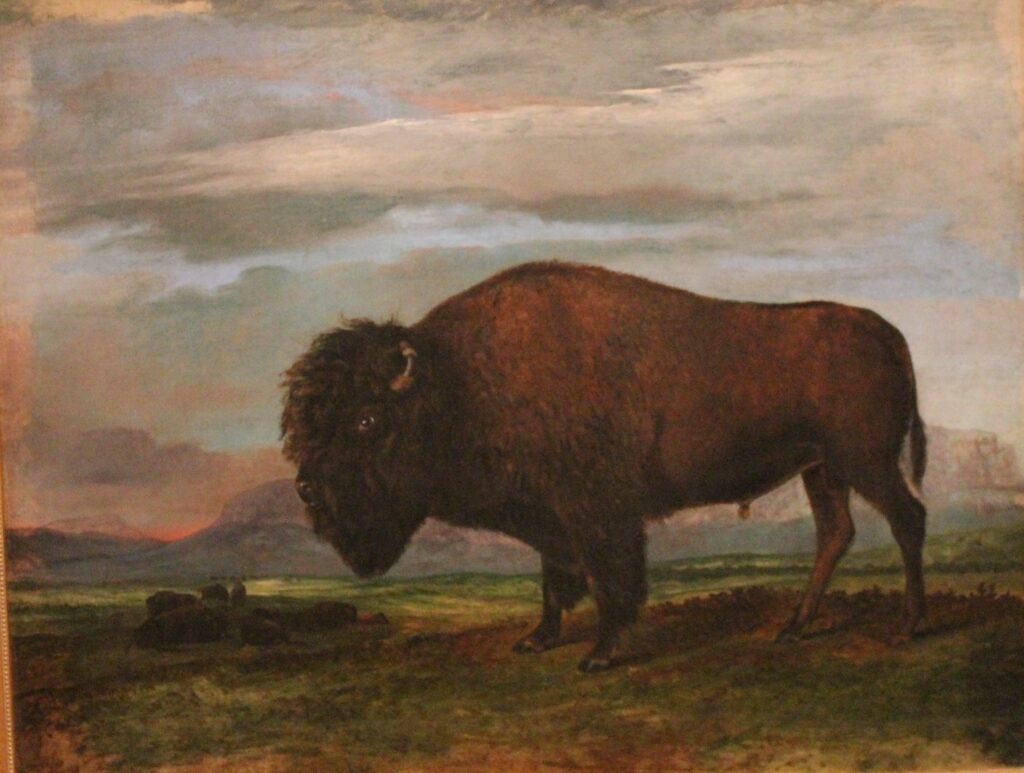
Oil on canvas
John Woodhouse Audubon (1812-1862)
L.S. Tyler Collection, JJA.1938.1328
Current Location: Storage
This unfinished oil paintings of a bison bull or buffalo is attributed to John James Audubon and his son, John Woodhouse Audubon. It was made for the Viviparous Quadrupeds of North America. The image shows a large male bison in the foreground and a herd of bison on the left in the middle and backgrounds. The bison are located in a prairie with mountains and a setting sun amongst a dark cloudy sky.
Purchased from the daughters of Mary Tyler Winters, whose parents were Leonard Sanford and Alice Tyler, in 1994 as part of the Tyler Collection. This sale was made possible through numerous donations made to the Friends of Audubon State Park, as well as contributions from the Preston Foundation and the Kentucky Department of Parks.
From our records, Mary Winters is quoted as saying, “I don’t have my entry on the Bison to hand, so these are just notes re its attribution and provenance. Edward Dwight attributed the Bison to John Woodhouse Audubon on his visit to Henderson in 1972.” According to Audubon family lore, John James Audubon painted the bison in 1843 from a bull that he killed in Montana. It appears to have been re-worked by his son, John Woodhouse Audubon, probably about 1862. The painting remained the property of the Audubon family (though loaned to the Audubon Museum since 1938) until the museum purchased it in 1994.
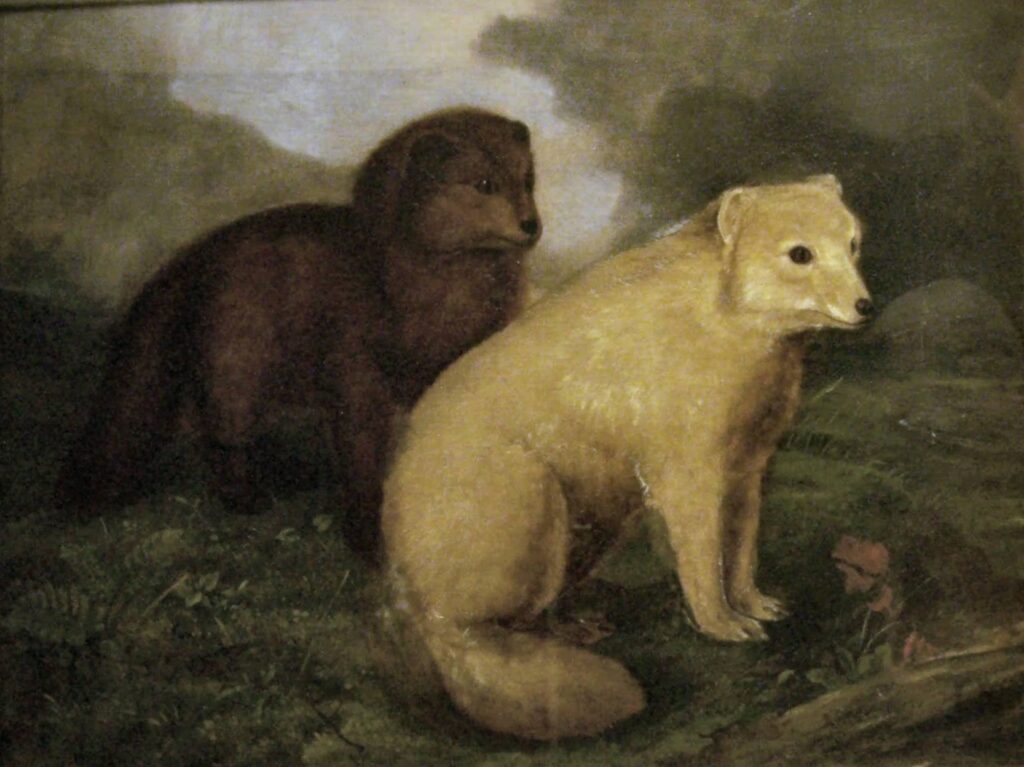
Oil on canvas
John Woodhouse Audubon (1812-1862)
L.S. Tyler Collection, JJA.1938.1330
Current Location: Storage
John Woodhouse Audubon made this oil painting for the Viviparous Quadrupeds of North America. It depicts two foxes in summer and winter coats. On the left side is a brown fox in its summer coat. The white fox on the right is shown in its winter coat. In the background, the sky is blue and prominently covered with dark grey clouds. The landscape around the foxes is grassy with a lake in the background.
The Tyler Collection was purchased in 1994 through numerous donations made to the Friends of Audubon State Park, as well as contributions from the Preston Foundation and the Kentucky Department of Parks.
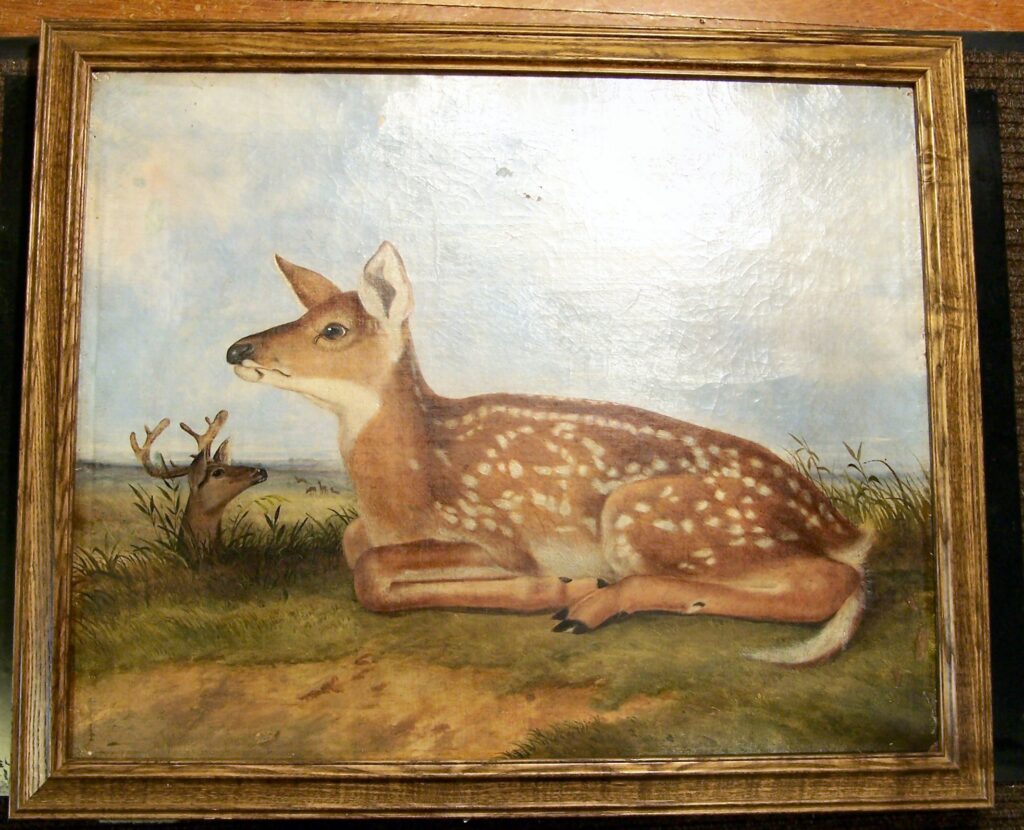
Oil on canvas
John Woodhouse Audubon (1812-1862)
L.S. Tyler Collection, JJA.1938.1331
Current Location: Gallery A
John Woodhouse created this oil painting for the Viviparous Quadrupeds of North America. It depicts a young whitetail fawn with white spots, laying to the left on a grassy knoll. To the left of the young deer is the head of an adult male deer with antlers visible just above the knoll. Four more deer can be seen in the distance. The landscape shown is a wide-open grassland.
The Tyler Collection was purchased in 1994 through numerous donations made to the Friends of Audubon State Park, as well as contributions from the Preston Foundation and the Kentucky Department of Parks.
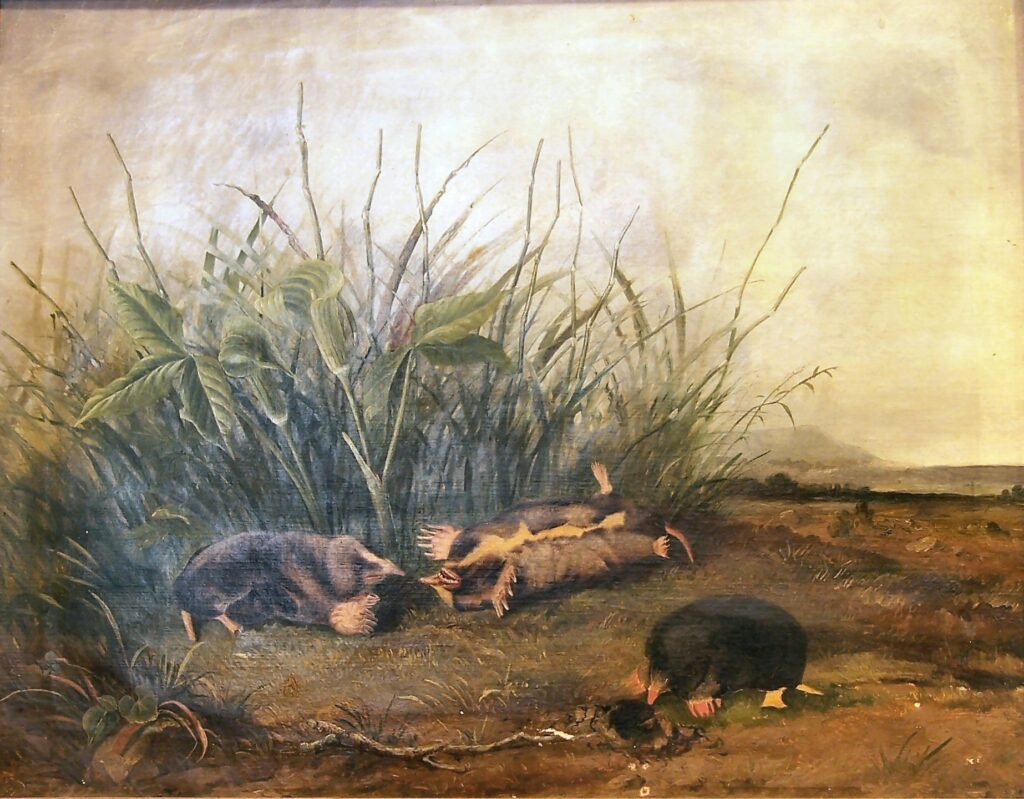
Oil on canvas
John Woodhouse Audubon (1812-1862)
L.S. Tyler Collection, JJA.1938.1332
Current Location: Gallery A
This oil painting by John Woodhouse Audubon for the Viviparous Quadrupeds of North America depicts three shrew moles. One mole lays on its back with its front and back legs splayed apart and mouth open with teeth shown. The mole – which appears to be dead – illustrates the coloration of its underside. A second mole with a black back, red nose, and red paws is shown peering into a hole. The third mole is shown standing on all fours in a right-facing position. The moles are shielded by grass on the left side and, to the left, is a wide-open grassland with hills in the far background.
The Tyler Collection was purchased in 1994 through numerous donations made to the Friends of Audubon State Park, as well as contributions from the Preston Foundation and the Kentucky Department of Parks.

Oil on canvas
John Woodhouse Audubon (1812-1862)
L.S. Tyler Collection, JJA.1938.1336
Current Location: Storage
John Woodhouse Audubon created this oil painting for the Viviparous Quadrupeds of North America. The painting shows three brown mice with white bellies sitting on rocks near a stream. They are situated in a grassy area with wide-open land in the background.
The Tyler Collection was purchased in 1994 through numerous donations made to the Friends of Audubon State Park, as well as contributions from the Preston Foundation and the Kentucky Department of Parks.
This piece is up for adoption through the Adopt-an-Artwork Program

Oil on canvas
John Woodhouse Audubon (1812-1862)
L.S. Tyler Collection, JJA.1938.1309
Current Location: Storage
John Woodhouse Audubon made this oil painting for the Viviparous Quadrupeds of North America, a joint project with his father, John James Audubon. In this painting, he shows three orange-brown-colored mice playing on rocks and a tree branch in a grassy area near water. A forest can be seen in the background. Along the lower half of the painting is an inscription in pencil, most of which is illegible.
The Tyler Collection was purchased in 1994 through numerous donations made to the Friends of Audubon State Park, as well as contributions from the Preston Foundation and the Kentucky Department of Parks.
This piece is up for adoption through the Adopt-an-Artwork Program
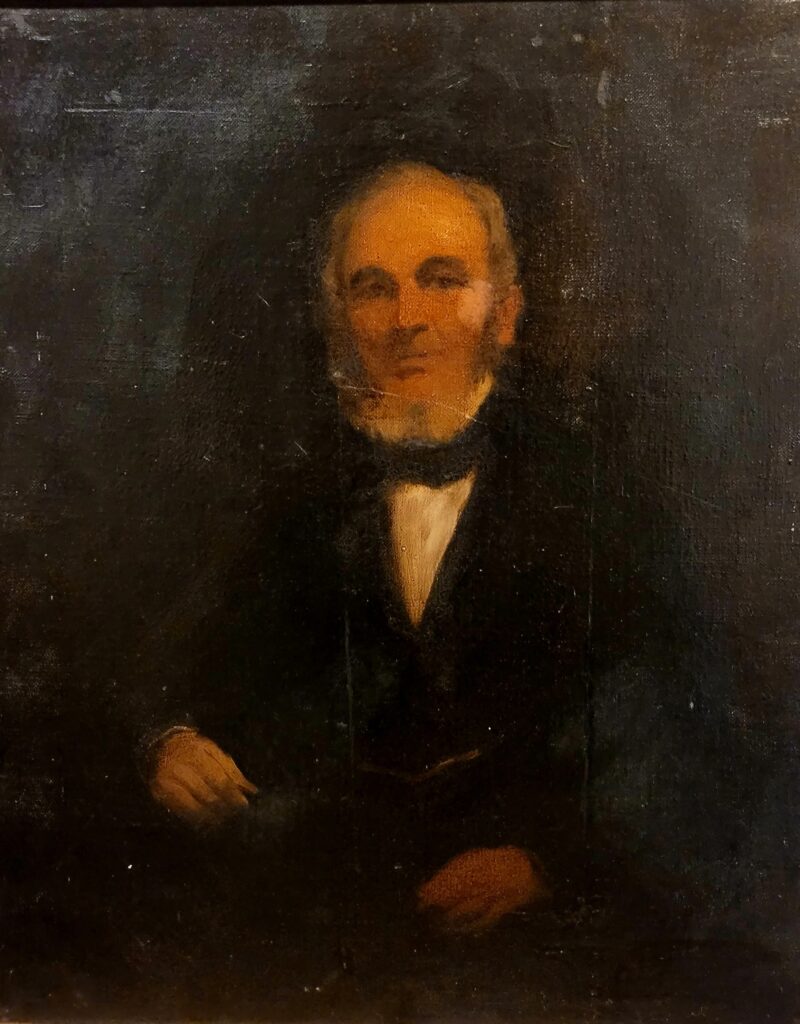
Oil on canvas
John Woodhouse Audubon (1812-1862)
L.S. Tyler Collection, JJA.1938.1323
Current Location: Storage
This is an oil painting of an unidentified elderly man done by John Woodhouse Audubon. The man is depicted in a sitting position from the waist up, facing the viewer. He has grey hair and a beard without a mustache. He wears a black suit with a cravat and white shirt. His hands are shown and it appears as though he is holding a book. The painting is very dark and appears unfinished.
The Tyler Collection was purchased in 1994 through numerous donations made to the Friends of Audubon State Park, as well as contributions from the Preston Foundation and the Kentucky Department of Parks.
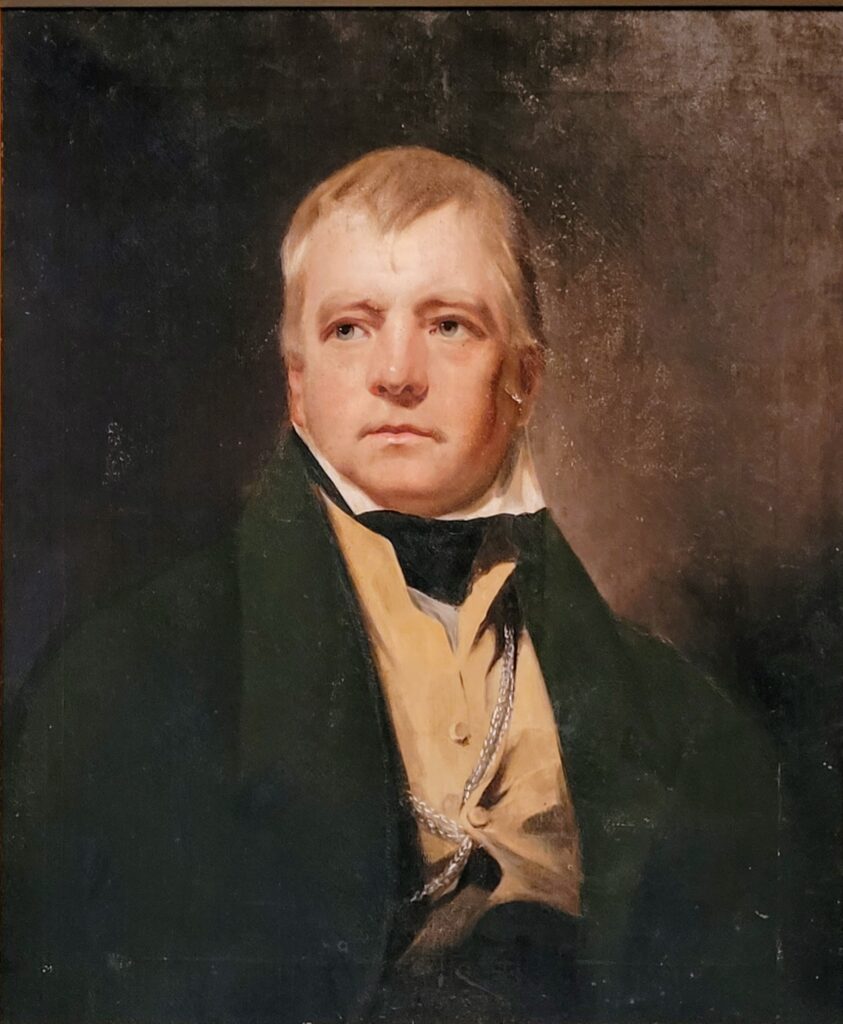
Oil on canvas
John Woodhouse Audubon (1812-1862)
L.S. Tyler Collection, JJA.1938.1308
Current Location: Storage
This is an oil painting of Scottish novelist, poet, playwright, and historian, Sir Walter Scott, by John Woodhouse Audubon. It depicts blond-haired, blue-eyed Sir Walter Scott from the chest up. He wears a black jacket, golden-yellow waistcoat, white shirt, and black cravat. The background is dark brown with a lighter shade of brown on the right side.
This painting is a copy of a portrait by Henry Raeburn done in 1832. On the back of Audubon’s portrait is a note reading, “Sir Walter Scott, after Sir. H. Raeburn, by J. W. Audubon, Edinburg, Nov 1, 1835.” John Woodhouse painted this portrait while in Abbotsford, Edinburgh, Scotland.
The Tyler Collection was purchased in 1994 through numerous donations made to the Friends of Audubon State Park, as well as contributions from the Preston Foundation and the Kentucky Department of Parks.
Works by Victor Gifford Audubon
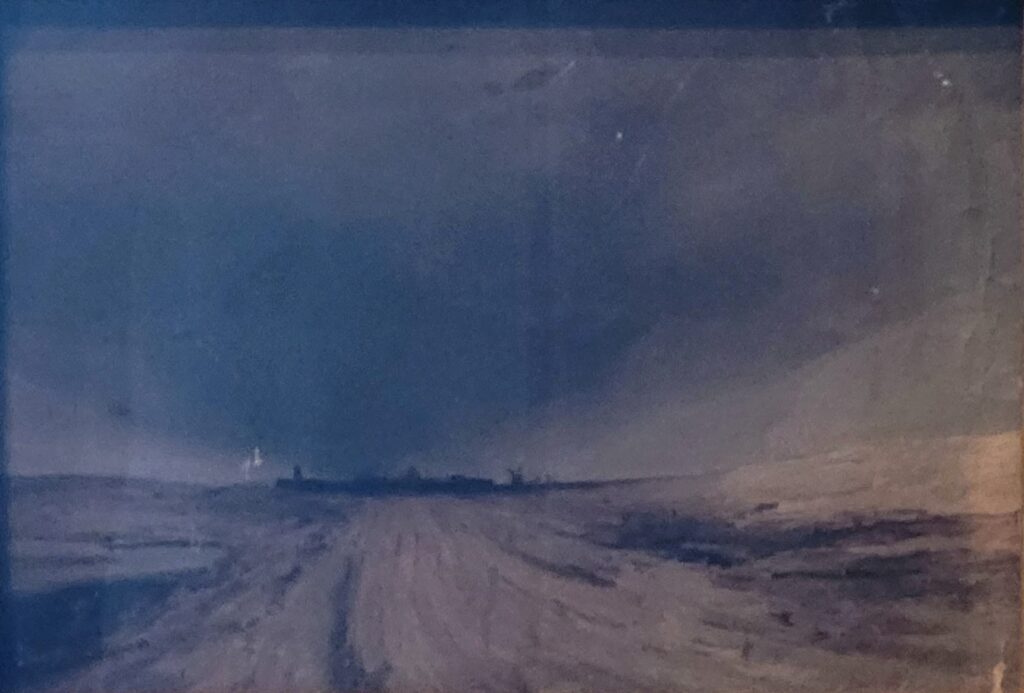
Oil on millboard
Victor Gifford Audubon
L.S. Tyler Collection, JJA.1938.1315
Current Location: Storage
This is an oil painting on millboard of Stirling Castle in Scotland by Victor Gifford Audubon. It shows a far-away view of the castle as it appeared from the road. The sky, road, and land are prominent in this image.
On the back of the painting is a label that reads, “This is the property of Annie Gordon Audubon.” Annie Gordon Audubon (1854-1907) was a daughter of Victor Gifford and Georgianna Richards Mallory Audubon (unknown-1882).
The Tyler Collection was purchased in 1994 through numerous donations made to the Friends of Audubon State Park, as well as contributions from the Preston Foundation and the Kentucky Department of Parks.
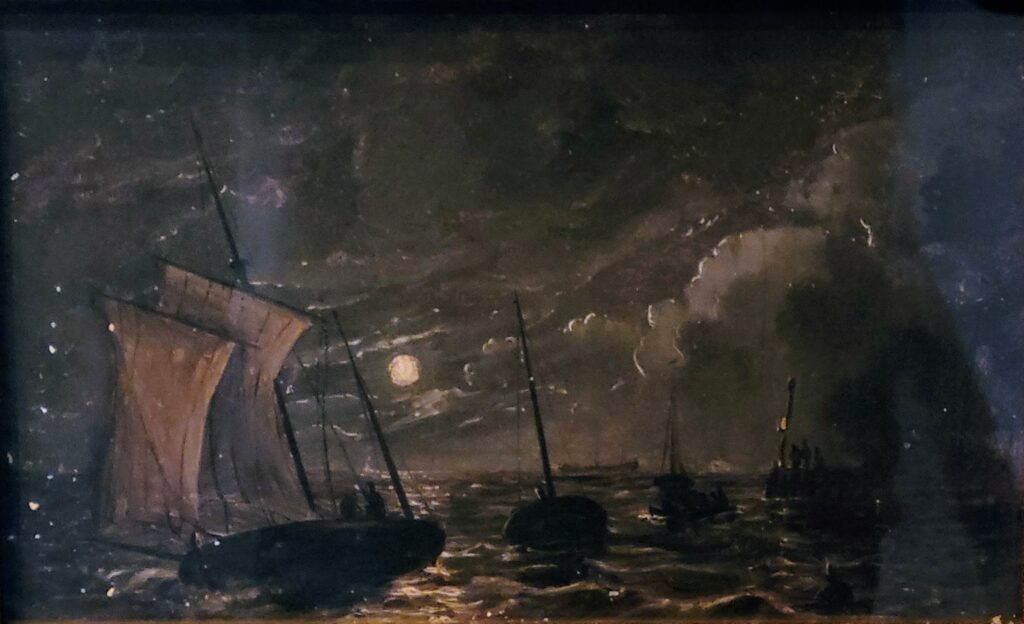
Oil on millboard
Victor Gifford Audubon
L.S. Tyler Collection, JJA.1938.1315
Current Location: Storage
Victor Gifford Audubon created this oil painting on millboard of a scene depicting ships at night. Several ships and a dory are shown near a wharf under moonlight and dark clouds. Non-descript figures are situated in the vessels. The sea is very dark.
On the back of the painting is a label that reads, “This is the property of Mary Eliza Audubon.” Mary Eliza Audubon (1845-1917) was a daughter of Victor Gifford and Georgianna Richards Mallory Audubon (unknown-1882).
The Tyler Collection was purchased in 1994 through numerous donations made to the Friends of Audubon State Park, as well as contributions from the Preston Foundation and the Kentucky Department of Parks.

Oil on millboard
Victor Gifford Audubon
L.S. Tyler Collection, JJA.1938.1319
Current Location: Storage
This oil painting on millboard by Victor Gifford Audubon depicts ships at a wharf. A number of vessels are shown, including a dory near the wharf with a male figure wearing a red cap, white vest, and blue shirt. His back faces the viewer as he rows the boat. Two other figures are faintly shown in another vessel in the background.
A label on the back of the painting reads, “This is the property of Rosa Audubon.” Rosa Audubon (1846-1879) was a daughter of Victor Gifford and Georgianna Richards Mallory Audubon (unknown-1882).
The Tyler Collection was purchased in 1994 through numerous donations made to the Friends of Audubon State Park, as well as contributions from the Preston Foundation and the Kentucky Department of Parks.
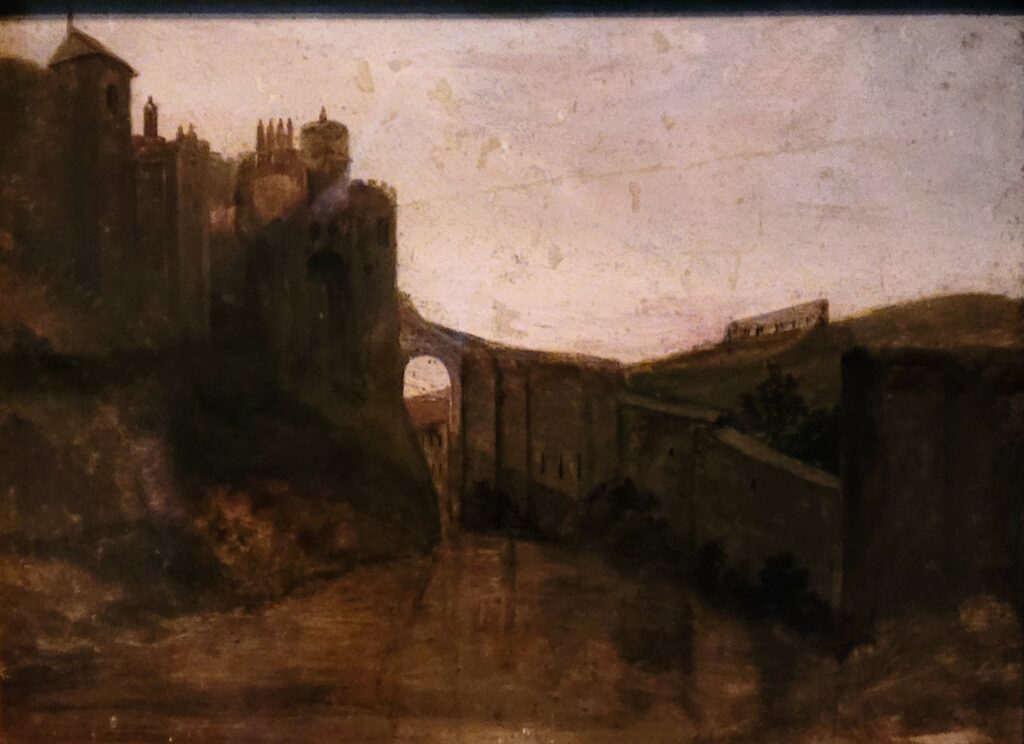
Oil on millboard
Victor Gifford Audubon
L.S. Tyler Collection, JJA.1938.1322
Current Location: Storage
This is an oil painting on millboard by Victor Gifford Audubon that depicts Edinburgh Castle in Scotland. The castle is shown in the upper left quadrant of the painting on a hill. It overlooks land with another stone structure. Between the two buildings is an arched stone gateway to the castle property.
The Tyler Collection was purchased in 1994 through numerous donations made to the Friends of Audubon State Park, as well as contributions from the Preston Foundation and the Kentucky Department of Parks.

Oil on millboard
Victor Gifford Audubon
L.S. Tyler Collection, JJA.1938.1318
Current Location: Storage
This oil painting on millboard by Victor Gifford Audubon depicts the interior arches of Chillon Castle on Lake Geneva, south of Veytaux in the canton of Vaud, Switzerland. It shows a single male figure in grey with a beige face.
A label on the back of the painting reads, “This is the property of Mary Eliza Audubon.” Mary Eliza Audubon (1845-1917) was a daughter of Victor Gifford and Georgianna Richards Mallory Audubon (unknown-1882). Also adhered to the back is a badly torn black and white image of Chillon Castle and a paper with printing.
The Tyler Collection was purchased in 1994 through numerous donations made to the Friends of Audubon State Park, as well as contributions from the Preston Foundation and the Kentucky Department of Parks.

Oil on millboard
Victor Gifford Audubon
L.S. Tyler Collection, JJA.1938.1324
Current Location: Storage
This oil painting on millboard by Victor Gifford Audubon depicts the arches of Oxford Castle in Oxfordshire, England. The image on the viewer’s left shows stone steps leading to another floor of the castle in addition to the stone arches. On the right, the image shows arches from the outside leading inward.
A paper label on the back of the painting reads, “This is the property of Lucy Bakewell Audubon.” Lucy Bakewell Audubon (1851-1898) was a daughter of Victor Gifford and Georgianna Richards Mallory Audubon (unknown-1882).
The Tyler Collection was purchased in 1994 through numerous donations made to the Friends of Audubon State Park, as well as contributions from the Preston Foundation and the Kentucky Department of Parks.
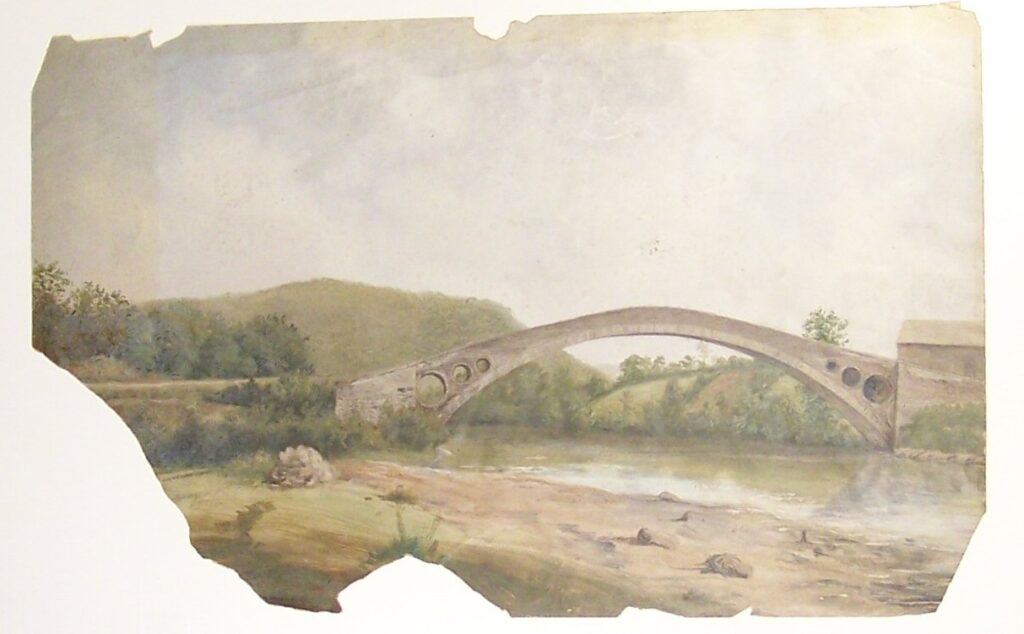
Watercolor on paper
Victor Gifford Audubon (1809-1860)
L.S. Tyler Collection, JJA.1938.1326
Current Location: Storage
Victor Gifford Audubon finished this watercolor painting of the Pontypridd Bridge (now also known as the William Edwards Bridge) in Wales in 1835. It shows a concrete bridge going over a river and leading to a house on the far right side. A large hill with a cloud-covered sky can also be seen in the background. Large portions of the image have been lost. The back of the image contains a series of inscriptions that read, “Pont y Prid from Below the Bridg, June 9, 1835, Walst North.”
The Tyler Collection was purchased in 1994 through numerous donations made to the Friends of Audubon State Park, as well as contributions from the Preston Foundation and the Kentucky Department of Parks.
Further Learning
Interested in knowing more about John Woodhouse and Victor Gifford Audubon? If you’re visiting the Audubon Museum in person, take a walk around the galleries. You will find John James Audubon’s portraits of his sons as children, learn about their contributions to Audubon’s projects, and see more of John Woodhouse’s artwork.
This post was written by Heidi Taylor-Caudill, museum curator at John James Audubon State Park. Questions? Contact Heidi at [email protected].

